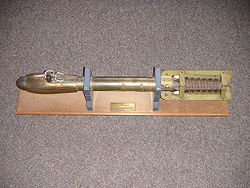
Bathythermograph
Encyclopedia

Temperature
Temperature is a physical property of matter that quantitatively expresses the common notions of hot and cold. Objects of low temperature are cold, while various degrees of higher temperatures are referred to as warm or hot...
sensor
Sensor
A sensor is a device that measures a physical quantity and converts it into a signal which can be read by an observer or by an instrument. For example, a mercury-in-glass thermometer converts the measured temperature into expansion and contraction of a liquid which can be read on a calibrated...
and a transducer
Transducer
A transducer is a device that converts one type of energy to another. Energy types include electrical, mechanical, electromagnetic , chemical, acoustic or thermal energy. While the term transducer commonly implies the use of a sensor/detector, any device which converts energy can be considered a...
to detect changes in water temperature versus depth. Lowered into the water from an underway ship, the BT records pressure and temperature changes as it is dropped through the water. Because the pressure is a function
Function (mathematics)
In mathematics, a function associates one quantity, the argument of the function, also known as the input, with another quantity, the value of the function, also known as the output. A function assigns exactly one output to each input. The argument and the value may be real numbers, but they can...
of depth (see Pascal's law
Pascal's law
In the physical sciences, Pascal's law or the Principle of transmission of fluid-pressure states that "pressure exerted anywhere in a confined incompressible fluid is transmitted equally in all directions throughout the fluid such that the pressure ratio remains the same." The law was established...
), temperature measurements can be correlated with the depth at which they are recorded. The bathythermograph was first developed by Athelstan Spilhaus
Athelstan Spilhaus
Athelstan Frederick Spilhaus was a South African-American geophysicist and oceanographer. He was born in Cape Town, South Africa. He became a US citizen in 1946...
in 1938.
World War II use on U.S. submarines
Since water temperature may vary by layer and may affect sonarSonar
Sonar is a technique that uses sound propagation to navigate, communicate with or detect other vessels...
by producing inaccurate location results, bathothermographs (U.S. World War II spelling) were installed on the outer hulls of U.S. submarines during World War II
World War II
World War II, or the Second World War , was a global conflict lasting from 1939 to 1945, involving most of the world's nations—including all of the great powers—eventually forming two opposing military alliances: the Allies and the Axis...
.
By monitoring variances, or lack of variances, in underwater temperature or pressure layers, while submerged, the submarine
Submarine
A submarine is a watercraft capable of independent operation below the surface of the water. It differs from a submersible, which has more limited underwater capability...
commander could adjust and compensate for temperature layers that could affect sonar
Sonar
Sonar is a technique that uses sound propagation to navigate, communicate with or detect other vessels...
accuracy. This was especially important when firing torpedoes at a target based strictly on a sonar fix.
More importantly, when the submarine was under attack by a surface vessel using sonar, the information from the bathothermograph allowed the submarine commander to seek thermocline
Thermocline
A thermocline is a thin but distinct layer in a large body of fluid , in which temperature changes more rapidly with depth than it does in the layers above or below...
s, which are colder layers of water, that would distort the pinging from the surface vessel's sonar, allowing the submarine under attack to "disguise" its actual position and to escape depth charge damage and eventually to escape from the surface vessel.
Source:
External links
- A bathythermograph, displayed by Jerome NamiasJerome NamiasJerome Namias was a U.S. meteorologist, whose research included El Niño.Namias was born in Bridgeport, Connecticut and grew up in Fall River, Massachusetts...

